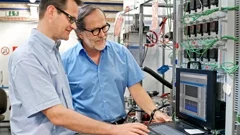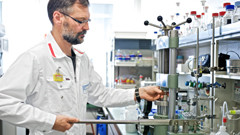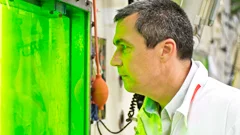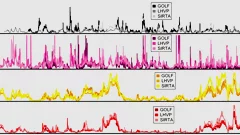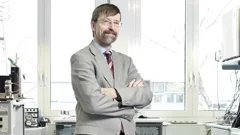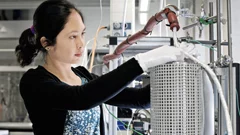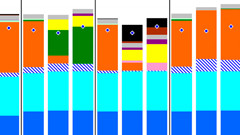Energy and Climate
The energy research performed at PSI focuses on processes that can be used in sustainable and safer technologies, ideally with minimal CO2 emissions. The main emphasis is on renewable energy sources. The ESI (Energy System Integration) platform enables research and industry to test solutions for integrating renewables into the existing energy supply. Another focus in this area is the safer use of nuclear energy. These activities are supplemented by analyses giving a comprehensive assessment of energy systems. PSI scientists in the Energy and Environment division study the chemical processes that take place in the atmosphere.
Find out more at: Overview Energy and Climate
Sharper image of a catalyst – warts and all
A catalyst made of the noble metal ruthenium supported on a carbon substrate is frequently used industrially. A prime example is the synthesis of ammonia, which, among other things, is involved in the production of nitrogenous fertilisers. Many research groups all over the world are looking to optimise this type of catalyst as it would increase the efficiency of one of the economically most important industrial processes. However, our understanding of how the catalytically active centres in the catalyst develop has been somewhat patchy thus far. Researchers from the Paul Scherrer Institute PSI can now unveil some fresh insights.
Zukünftige Computerchips mit "elektronischem Blutkreislauf"
Im Rahmen des Sinergia-Programms fördert der Schweizerische Nationalfonds das dreijährige Forschungsvorhaben REPCOOL. Unter der Leitung von IBM Research à Zürich arbeiten in diesem Projekt Wissenschaftler der ETH Zürich, des Paul Scherrer Instituts in Villigen und der Università della Svizzera italiana in Lugano gemeinsam an der Erforschung eines elektronischen Blutkreislaufs für zukünftige 3D-Computerchips. Vom menschlichen Gehirn inspiriert, entwickeln die Forscher ein Mikrokanalsystem mit einer elektrochemischen Flussbatterie, die 3D-Chipstapel gleichzeitig kühlen und mit Energie versorgen. Ultimatives Ziel ist die Entwicklung eines Supercomputers in PC-Grösse.This news release is only available in German.
A glimpse at the future of global energy supply
How will the world secure its energy supply in 2050 and what are the possible economic, ecological and social implications of different pathways and choices? These questions are answered by researchers at the Paul Scherrer Institute PSI in cooperation with the World Energy Council WEC in a study examining two scenarios covering different dimensions of economic, social, policy and technology development. The results of the study, which has now been concluded, will be presented from 13 to 17 October at the WEC’s World Energy Congress in the South Korean town of Daegu
Particle formation in the atmosphere – further aspect unveiled via the CLOUD experiment at CERN
Clouds consist of cloud droplets that are formed from tiny particles floating in the atmosphere. How these particles develop, however, largely remains a mystery. The formation of particles from amines and sulphuric acid has now been described for the first time à a milestone in atmospheric research.
Computer simulations: a cornerstone of nuclear power station safety
Without computer simulations, the operation of nuclear power stations would be very difficult. Whether it is a question of installing new components or conducting safety tests, virtually everything has to be calculated and analysed on the computer first. At the Laboratory for Reactor Physics and Systems Behaviour of the Paul Scherrer Institute PSI, computational models and methodologies are developed with precisely this in mind. Through this, PSI researchers also act as an independent partner to the national regulatory authority ENSI and contribute thereby to support safe operation of the Swiss nuclear power plants.
Well-rounded concept for less nuclear waste
The idea of producing fuel for nuclear power stations in form of a package of spheres instead of today’s customary pellets was already born back in the 1960s. There was promise of a subsequent simplification of fuel production and a considerable reduction in the amount of radioactive waste both in the production of the fuel itself and after its use in a nuclear power station. However, the spherical fuel was never implemented as the fast reactors for which it was conceived were never built at a large scale. The Paul Scherrer Institute (PSI) has also been involved in the research on spherical fuel in the past. Now several projects partly funded by the EU are currently underway at the PSI again to refine the production of fuel spheres further. This form of fuel could either be used in special plants to reduce waste or in fast generation IV reactors, which in a closed cycle also produce less long-lived waste.
Reconstruction of the Fukushima nuclear accident
Researchers at the Paul Scherrer Institute (PSI) are currently involved in an international project aimed at reconstructing what happened to the reactor units during the nuclear accident at the Japanese nuclear power station, Fukushima Daiichi in March 2011. In particular, the estimate of the core end-state will help the owner of the damaged plant, the Tokyo Electricity Power Company (TEPCO) to plan the removal of components from the reactor containment and the final decontamination. Besides, the exercise is intended to contribute to further refinement of the computer programs used to perform nuclear accident simulations
Five times less platinum: fuel cells could become economically more attractive thanks to novel aerogel catalyst.
Fuel cells that convert hydrogen into power and only produce pure water as a by-product have the potential to lead individual mobility into an environmentally friendly future. The Paul Scherrer Institute (PSI) has been researching and developing such low-temperature polymer electrolyte fuel cells for more than 10 years and initial field tests have already demonstrated the successful use of these fuel cells in cars and buses. However, further research is still required to improve the durability and economic viability of the technology. An international team of researchers involving the PSI has now manufactured and characterised a novel nanomaterial that could vastly increase the efficiency and shelf-life of these fuel cells à as well as reduce material costs.
How radionuclides escape through rock: insights for a geological waste storage site
How do radioactive substances move through the host rock in a deep repository for nuclear waste? Researchers from the Diffusion Processes Group in the Laboratory of Waste Management at the Paul Scherrer Institute (PSI) have been investigating. The transport properties of negatively charged radionuclides, which are repelled by the negatively charged surfaces of clay minerals and thus hardly adhere to the rock, are well known. An EU project in which the PSI is also involved is now yielding similar insights into positively charged and therefore highly adherent radionuclides.
Knowledge for tomorrow from "hot cells"
The manipulation and examination of irradiated and therefore radioactive objects, be they from nuclear power stations or research facilities, requires strict safety measures. Tests may only be conducted in so-called hot cells, where the radioactivity is hermetically enclosed and shielded behind concrete and lead walls up to 1 metre thick. In the hot cells of the PSI hot lab, the burnt-off fuel rods from the Swiss nuclear power stations are studied from a materials science perspective. The insights gained help nuclear power station operators to optimise the efficiency and safety of their plants. Besides this service, the hot lab is involved in several international research projects.
Not a drop too much
The supply of a vapour saturated gas mixture plays a crucial role in many industrial processes. In this way, for example, the emission of nitrogen oxides during diesel combustion can be reduced by ensuring high vapour saturation of the gas mixture. A scientist at the Paul Scherrer Institute has come up with an invention which enables this to be implemented industrially in the future via a simple, flexible and robust technique.
Fast neutrons for improved safety
Neutrons are an excellent tool for the non-destructive imaging the interior of objects. They can provide a valuable complement to the more widely used x ray radiography. For some materials that are virtually opaque or for those that cannot be distinguished by X-rays, neutrons provide the only informative dissection tool. However, neutron radiography is mainly confined to the laboratory and fixed facilities, because neutron generation relies on equipment like nuclear reactors or particle accelerators, which are costly, complex and cannot be moved. Scientists at the Laboratory for Thermohydraulics at the Paul Scherrer Institute PSI want to develop a more flexible imaging technique based on fast neutrons.
ecoinvent – The World’s Leading LCA Database Launches Version 3.0
The life cycle inventory database ecoinvent forms the basis for life cycle assessment projects, eco-design, and product environmental information. Since 2003, ecoinvent has enabled companies to manufacture their products more in harmony with the environment, policymakers to implement new policies, and consumers to adopt more environmentally friendly behaviour. The new version 3.0 is a further milestone in life cycle assessment: new and updated data offer ecoinvent users a greater number of possible applications in the areas of e.g. chemical production, foodstuffs, vegetables and electricity.
Waste incineration: the last word in cleanliness?
Household waste always used to end up left untreated in landfills, and the effects of this practice are well-known: these waste disposal sites were quite often ecological "death zones". With the incineration of municipal waste, there was some mitigation of this problem: despite the overall increase in quantities of waste, the areas claimed by landfill have been limited in recent decades thanks to waste recycling and incineration. However, waste incineration remains far from a panacea. Some combustion products that are already present in the burnt materials or that arise just during the combustion process itself are harmful to human health and the environment and some of them still find their way out of waste incineration plants and into landfill sites as their final destination.
Air quality in the megacity Paris: better than expected
Megacities are often perceived by the public to be major sources of air pollution, which affect their surroundings as well. However, recent studies show that the environmental credentials of cities with over one million inhabitants are not so bad after all. An international team of researchers, including scientists from the Paul Scherrer Institute (PSI), has now confirmed, on the basis of aerosol measurements carried out in Paris, that so-called post-industrial cities affect the air quality of their immediate surroundings far less than might be thought.
An ultrathin energy storage device made of carbon
For the discovery and characterisation of the miraculous material graphene à a layer of carbon exactly 1 atom thickà two Russian born physicists were awarded the Nobel Prize in 2010 and got a huge amount of media attention. Ever since graphene was first isolated, scientists all over the world have been rushing to find applications. Recently, scientists at the Paul Scherrer Institute PSI laid the foundations for a graphene-based super capacitor. With its help, the lifespan of batteries in hybrid cars could be extended significantly
Memory effect now also found in lithium-ion batteries
Lithium-ion batteries are high performance energy storage devices used in many commercial electronic appliances. Certainly, they can store a large amount of energy in a relatively small volume. They have also previously been widely believed to exhibit no memory effect. That’s how experts call a deviation in the working voltage of the battery, caused by incomplete charging or discharging, that can lead to only part of the stored energy being available and an inability to determine the charge level of the battery reliably. Scientists at the Paul Scherrer Institute PSI, together with colleagues from the Toyota Research Laboratories in Japan have now however discovered that a widely-used type of lithium-ion battery has a memory effect. This discovery is of particularly high relevance for advances towards using lithium-ion batteries in the electric vehicle market. The work was published today in the scientific journal Nature Materials.
The golden way to choke harmful exhaust gases
Exhaust gases produced by diesel combustion are freed from harmful nitrogen oxides with the aid of an aqueous urea solution. That’s the state of the art. The urea decomposes into ammonia and this, in turn, reduces the nitrogen oxides into harmless nitrogen. However, the urea solution can produce undesirable solid residues and, in addition, freeze in extremely cold weather. Now researchers at the Paul Scherrer Institut (PSI) have developed a catalyst which can be used with better reducing agents than urea for nitrogen oxide reduction.
From methane to methanol - or how to extinguish the torches of waste
In nighttime photographs taken from space, the large cities of the world can easily be recognised by the flood of their public lighting. However, probably only the trained eye is able to see, as well as New York or Tokyo, the locations of many oil-producing wells . The light in these cases originates mainly from the combustion of methane. This huge waste of an energy-rich gas has devastating economic and ecological consequences. Reasearchers at the Paul Scherrer Institute PSI are looking for a solution: the conversion of methane into the liquid energy carrier methanol
Scenarios for the transformation of Switzerland's electricity system
Researchers in the Energy Economics Group at the Paul Scherrer Institute PSI have used their model of the Swiss electricity system called STEM-E to analyze various electricity supply scenarios. They have concluded that alternatives to today's electricity supply are associated with different costs, risks and opportunities. Realising sustainability objectives such as climate protection while phasing out nuclear generation and making Switzerland's electricity supply independent of foreign countries raises many challenges. Furthermore, their analysis suggests that costs of electricity production are likely to increase by at least 50 percent by 2050







